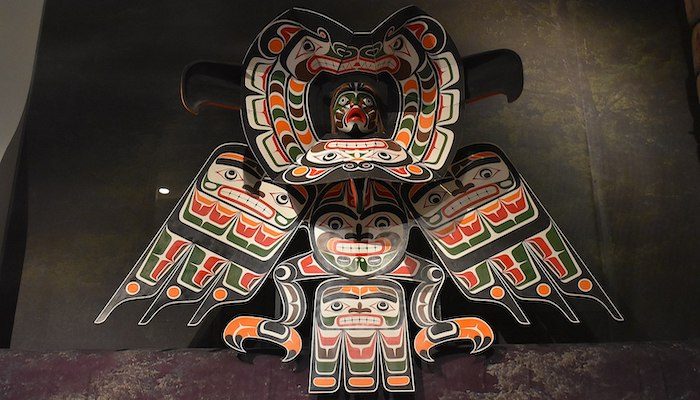
This is adapted from International Relations Theory (2017). Get your free copy of the textbook here.
Featured image from Jon Kolbert, CC-BY-SA-4.0, via Wikimedia Commons.
There is an emerging scholarship on Indigenous international relations that challenges state-centric expressions of sovereignty and self-determination. As Anishinaabe scholar Hayden King (2015, 181) states, ‘in our political worldviews the state and sovereignty melt away’. Indigenous nations have expressed solidarity with one another through the establishment of new confederacies, treaties and agreements that promote peace, friendship and new strategic alliances. Indigenous international relations are enduring and sacred, and making treaties with foreign countries has not prevented Indigenous nations from continuing their own diplomatic relations with one another. For example, the Treaty of Peace, Respect, and Responsibility between the Heiltsuk Nation and the Haida Nation (Crist 2014) was the first peace treaty between these two nations since the 1850s and was premised on the assumption that ‘there are greater troubles facing our lands and waters and depletion of resources generated from forces outside of our nations’. The Treaty was enacted between the two Indigenous nations through a potlatch ceremony and sought to challenge a common threat posed by the state- sanctioned commercial herring fishery in Heiltsuk waters.
In 2014, another historic treaty was initiated between Indigenous nations living along the medicine line (the United States-Canada border). Iiniiwa, which is the Blackfoot name for bison, have a deep, longstanding relationship with the land, people and cultural practices of prairie ecosystems. When discussing the role of the bison on their homelands, Blackfoot scholar Leroy Little Bear (2014) pointed out that
[a]cting as a natural bio-engineer in prairie landscapes, they shaped plant communities, transported and recycled nutrients, created habitat variability that benefited grassland birds, insects and small mammals, and provided abundant food resources for grizzly bears, wolves and humans.
Unfortunately, the widespread slaughter of bison in the nineteenth century led to the deterioration of the prairie ecosystems and with this the health and wellbeing of Blackfeet people. The decimation of the bison also impacted the cultural practices of the region’s Indigenous peoples, which has prompted the need for community-led action to restore the iiniiwa to Indigenous homelands.
On 23 September 2014, eight Indigenous nations (the Blackfeet Nation, Blood Tribe, Siksika Nation, Piikani Nation, the Assiniboine and Gros Ventre Tribes of Fort Belknap Indian Reservation, the Assiniboine and Sioux Tribes of Fort Peck Indian Reservation, the Salish and Kootenai Tribes of the Confederated Salish and Kootenai Indian Reservation, and the Tsuu T’ina Nation) gathered in Blackfeet territory near Browning, Montana to sign the historic Buffalo Treaty.
It involved Indigenous nations on both sides of the medicine line and called for the return of iiniiwa to the prairie ecosystems. Given that it was the first cross-border Indigenous treaty signed in over 150 years, the Buffalo Treaty was also a way of renewing and regenerating old alliances. It outlined several community-led goals, including engaging tribes and First Nations in continuing dialogue on iiniiwa conservation; uniting the political power of the tribes and First Nations of the Northern Great Plains; advancing an international call for the restoration of the iiniiwa; engaging youth in the treaty process and strengthening and renewing ancient cultural and spiritual relationships with iiniiwa and grasslands in the Northern Great Plains.
As an example of Indigenous international relations, the above-mentioned treaty provisions demonstrate the sacred nature of treaty-making as a way for Indigenous nations ‘to extend their relationships of connection to all of the different peoples of the world’ (Williams 1997, 50). In addition to having Indigenous nations as signatories, the Buffalo Treaty also outlines a vision for the involvement of federal, state and provincial governments, as well as farmers, ranchers and conservation groups in the restoration of iiniiwa to Indigenous homelands. As individual Indigenous nations, these communities would have a limited ability to promote iiniiwa restoration. However, with a unified vision, they collectively exerted their self-determining authority to facilitate the return of iiniiwa to some 6.3 million acres of their homelands.
The Buffalo Treaty is also a living document that requires periodic renewal and re-interpretation. Two years after the Treaty was signed, the number of signatories had gone from eight to 21. In September 2016, signatories held a pipe ceremony in Banff National Park to honour the planned reintroduction of sixteen iiniiwa to the area. In addition to restoring the buffalo population, signatories called on the Government of Alberta in Canada to change the name of Tunnel Mountain in Banff to Sacred Buffalo Guardian Mountain. The vision for the regeneration and perpetuation of iiniiwa also entails changing the landscape to reflect the places where the iiniiwa live. New forms of Indigenous treaty-making reflect the complex diplomacies and spiritual re-awakenings that constitute Indigenous international relations.
A power imbalance, and differences in worldviews, between states and Indigenous nations remains in our international system. Developments and critiques within the discipline of IR, and how it is theorised, highlight the struggle of Indigenous peoples to maintain their place-based existence so that their lands, cultures, communities and relationships will flourish for generations to come. Indigenous understandings of international relations come in many forms, whether through reinvigorating treaties with the natural world, (re)establishing alliances between Indigenous peoples or Indigenous advocacy in diplomatic activities within global forums. These efforts challenge the dominant state-centric system to include their different ways of understanding and structuring relations not just between peoples, but with the natural world and the planet. More specifically, they challenge the Westphalian notion of ultimate state sovereignty and seek ways of restoring self- determining authority regarding their relationships to their homelands and nations.
Further Reading on E-International Relations
- The First Continental Conference on Five Hundred Years of Indigenous Resistance
- Discovery, Conquest and Colonialism
- Student Feature – Theory in Action: Global South Perspectives on Development
- Student Feature – Theory in Action: Asian Perspectives on a ‘Chinese School’
- Student Feature – Theory in Action: Critical Geography and Inuit Views
- Student Feature – Theory in Action: Marxism, Migrants and Borders